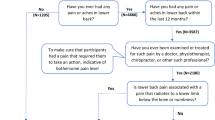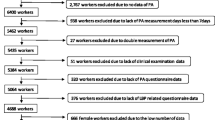Abstract
Introduction
Physical activity is suggested to be important for low back pain (LBP) but a major problem is the limited validity of the measurement of physical activities, which is usually based on questionnaires. Physical fitness can be viewed as a more objective measurement and our question was how physical activity based on self-reports and objective measured levels of physical fitness were associated with LBP.
Materials and methods
We analyzed cross-sectional data of 1,723 police employees. Physical activity was assessed by questionnaire (SQUASH) measuring type of activity, intensity, and time spent on these activities. Physical fitness was based on muscular dynamic endurance capacity and peak oxygen uptake (VO2 peak). Severe LBP, interfering with functioning, was defined by pain ratings ≥4 on a scale of 0–10.
Results
Higher levels of physical fitness, both muscular and aerobic, were associated with less LBP (OR: 0.54; 95% CI: 0.34–0.86, respectively, 0.59: 95%CI: 0.35–0.99). For self-reported physical activity, both a low and a high level of the total physical activity pattern were associated with an increase of LBP (OR: 1.52; 95%CI: 1.00–2.31, respectively, 1.60; 95%CI: 1.05–2.44).
Conclusion
These findings suggest that physical activity of an intensity that improves physical fitness may be important in the prevention of LBP.
Similar content being viewed by others
References
van Weering MG, Vollenbroek-Hutten MM, Tönis TM et al (2009) Daily physical activities in chronic lower back pain patients assessed with accelerometry. Eur J Pain 13(6):649–654
Jacob T, Baras M, Zeev A et al (2004) Physical activities and low back pain: a community-based study. Med Sci Sports Exerc 36(1):9–15
Heneweer H, Staes F, Aufdemkampe G, van Rijn M et al (2011) Physical activity and low back pain: a systematic review of recent literature. Eur Spine J 20:826–845
Sitthipornvorakul E, Janwantanakul P, Purepong N et al (2011) The association between physical activity and neck and low back pain: a systematic review. Eur Spine J 20(5):677–689
Heneweer H, Vanhees L, Picavet HSJ (2009) Physical activity and low back pain: a U-shaped relation? Pain 143:21–25
Shephard RJ (2003) Limits to the measurement of habitual physical activity by questionnaires. Br J Sports Med 37:197–206
Vanhees L, Lefevre J, Philippaerts R et al (2005) How to assess physical activity? How to assess physical fitness? Eur J Cardiovasc Prev Rehabil 12(2):102–114
Picavet HSJ, Schuit AJ (2003) Physical activity: a risk factor for low back pain in the general population? J Epidemiol Commun Health 57:517–518
Protas EJ (1996) Aerobic exercise in the rehabilitation of individuals with chronic low back pain: a review. Crit Rev Phys Rehabil Med 8:283–295
Verbunt JA, Westerterp KR, van der Heijden GJ et al (2001) Physical activity in daily life in patients with chronic low back pain. Arch Med Rehabil 82:726–730
Picavet HSJ, Wendel-Vos GCW (2011) Use it or lose it, but how to use? Pain Commentary (in press)
Blair SN, Cheng Y, Holder JS (2001) Is physical activity or physical fitness more important in defining health benefits? Med Sci Sports Exerc 33(6 Suppl):S379–S399
Duque I, Parra JH, Duvallet A (2009) Physical deconditioning in chronic low back pain. J Rehabil Med 41:262–266
Adams MA, Mannion AF, Dolan P (1999) Personal risk factors for first time low back pain. Spine 24:2497–2505
Alaranta H, Luoto S, Heliovaara M et al (1995) Static back endurance and the risk of low back pain. Clin Biomech 10:323–324
Biering Sørensen F (1984) Physical measurements as risk indicators for low back trouble over a one year period. Spine 9:106–119
Stevenson JM, Weber CL, Smith JT et al (2001) A longitudinal study of the development of low back pain in an industrial population. Spine 26:1370–1377
Suni JH, Oja P, Miilunpalo SI et al (1998) Health-related fitness test battery for adults: associations with perceived health, mobility, and back function and symptoms. Arch Phys Med Rehabil 79(5):559–569
Takala EP, Viikari Juntura E (2000) Do functional tests predict low back pain? Spine 25:2126–2132
Smeets RJEM, Wittink H, Hidding A et al (2006) Do patients with chronic low back pain have a lower level of aerobic fitness than healthy controls? Spine 31(1):90–97
Verbunt JA, Seelen HA, Vlaeyen JWS et al (2003) Disuse and deconditioning in chronic low back pain: concepts and hypothesis on contributing mechanisms. Eur J Pain 84:9–21
Burton AK, Balague F, Cardon G et al (2005) How to prevent low back pain. Best Pract Res Clin Rheumatol 19:541–555
Linton SJ, van Tulder MW (2001) Preventive interventions for back and neck pain problems: what is the evidence? Spine 26:778–787
van Tulder MW, Koes BW, Bouter LM (1995) A cost-of illness study of back pain in the Netherlands. Pain 62:233–240
Krebs EE, Carey TS, Weinberger M (2007) Accuracy of the pain numeric scale as a screening test in primary care. J Gen Intern Med 22(10):1453–1458
Wendel-Vos GCW, Schuit AJ (2002) Short questionnaire to assess health enhancing physical activity. National Institute of Public Health and the Environment, Center for Chronic Diseases Epidemiology, Bilthoven
Wendel-Vos GCW, Schuit AJ, Saris WHM et al (2003) Reproducibility and relative validity of the Short Questionnaire to Assess Health-enhancing physical activity. J Clin Epidemiol 56:1163–1169
Ainsworth BE, Haskell WL, Whitt MC et al (2000) Compendium of physical activities: an update of activity codes and MET intensities. Med Sci Sports Exerc 32(suppl 9):498–504
Grundy SM, Cleeman JL, Daniels SR et al (2005) Diagnosis and management of the metabolic syndrome: an American Heart Association/National Heart and Lung, and Blood Institute scientific statement. Circulation 112:2735–2752
Hamberg-van Reenen HH, Ariens GA, Blatter BM et al (2006) Is an imbalance between physical capacity and exposure to work-related physical factors associated with low-back, neck or shoulder pain? Scand J Work Environ Health 32:190–197
Suni JH (1999) Health-related fitness test battery for middle-aged adults: with emphasis on musculoskeletal and motor tests. Department of Health Sciences, University of Jyväskylä, Finland
Hamberg-van Reenen HH, Ariëns GAM, Blatter BM et al (2007) A systematic review of the relation between physical capacity and future low back and neck/shoulder pain. Pain 130:93–107
George SZ, Teyhen DS, Wu SS et al (2009) Psychosocial education improves low back pain beliefs: results from a cluster randomized clinical trial (NCT00373009) in a primary prevention setting. Eur Spine J 18(7):1050–1058
Kremer EF, Block A, Gaylor MS (1981) Behavioral approaches to treatment of chronic pain: the inaccuracy of patient self-reported measures. Arch Phys Med Rehabil 62(4):188–191
Fogelholm M, Malmberg J, Suni J et al (2006) International Physical Activity Questionnaire: validity against fitness. Med Sci Sports Exerc 38(4):753–760
Rzewnicki R, Vanden Auweele Y, De Bourdeauhuij I (2003) Addressing overreporting on the International Physical Activity Questionnaire (IPAQ) telephone survey with a population sample. Public Health Nutr 6(3):299–305
Klesges RC, Eck LH, Mellon MW (1990) The accuracy of self-reports of physical activity. Med Sci Sports Exerc 22:690–697
Jacobs DR, Ainsworth BE, Hartman TJ, Leon AS (1993) A simultaneous evaluation of 10 commonly used activity questionnaires. Med Sci Sports Exerc 25(1):81–91
Williamson A, Hoggart B (2005) Pain: a review of three commonly used pain rating scales. J Clin Nurs 14:789–804
Fejer R, Jordan A, Hartvigsen J (2005) Categorising the severity of neck pain: establishment of cut points for use in clinical and epidemiological research. Pain 119:176–182
Serlin RC, Mendoza TR, Nakamura Y et al (1995) When is cancer pain mild, moderate or severe? Grading pain severity by its interference with function. Pain 61:277–284
Turner JA, Franklin G, Heagerty PJ et al (2004) The association between pain and disability. Pain 112:307–314
Conflict of interest
None.
Author information
Authors and Affiliations
Corresponding author
Rights and permissions
About this article
Cite this article
Heneweer, H., Picavet, H.S.J., Staes, F. et al. Physical fitness, rather than self-reported physical activities, is more strongly associated with low back pain: evidence from a working population. Eur Spine J 21, 1265–1272 (2012). https://doi.org/10.1007/s00586-011-2097-7
Received:
Revised:
Accepted:
Published:
Issue Date:
DOI: https://doi.org/10.1007/s00586-011-2097-7




